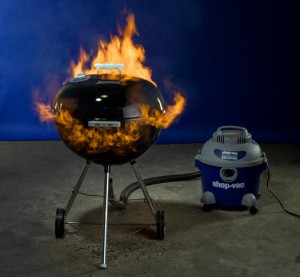Steve Jobs—it turns out—was more than a computer inventor. He also invented with glass. Besides using slipperly glass for the screens on the iPhone and iPad, he used huge sheets of glass to make a staircase. According to US Glass Industry News Network, he planned on using huge sheets of curved glass to make a new circle-shaped headquarters for Apple. Let’s learn more about this amazing substance.
1. How do you make glass?
At Popsci.com, science lover Theo Gray shows us that glass is made of sand and lime (or borax). The lime helps the sand melt evenly when heated. You can watch a movie of Theo making a glass ornament using a very hot charcoal grill. You can also learn that the first glass was first discovered around 7,000 years ago by Phoenician merchants.
 2. Which is stronger — Steel or glass?
2. Which is stronger — Steel or glass?
Until last year, it was steel. But at U.S. Department of Energy’s Berkeley Lab, you learn how scientists have mixed metals into glass, making it stronger than steel.
3. What is Gorilla Glass (and why should I care)?
If you’ve ever touched an iPhone or tablet, you’ve probably touched Gorilla Glass. There aren’t really any gorillas involved. At CorningGorillaGlass.com, you learn that Corning® Gorilla® Glass is merely a brand name for a new type of glass that has gone through a chemical strengthening process where large ions are “stuffed” into the glass surface, making it slippery and strong — perfect for phones, tablets and sun glasses.
4. Where is the largest sheet of glass?
According to FastCompany.com, one of Apple’s stores in Sydney Australia has 15-meter (45-foot) flat glass windows; the largest plates of laminated glass in the world. They are used to create a giant clear storefront. You can also read about Steve Jobs’ plans for a ‘spaceship-style’ building for Apple in Cupertino. See more pictures of the Sydney building at: http://bit.ly/rpOnuE.
 5. Is glass a liquid or a solid?
5. Is glass a liquid or a solid?
- There is no clear answer. At ScienceDaily.com, you learn that the best way to describe glass is that is an “amorphous solid” that acts like a solid but has some characteristics of a liquid. Learn more at University of California, Riverside, Department of Mathematics.
6. APPLICATION: Make your own glass cleaner.
Search “glass cleaning recipe” online, and you’ll find hundreds of different homemade solutions for making windows sparkle. One good example can be found at SimpleOrganizedLiving.com, where you learn how you can get a used plastic bottle and mix up a batch of water, vinegar and a little bit of corn starch to make some glass sparkle.
7. Want to see more?
Visit Children’s Technology Review’s playlist (below), to view select YouTube videos based on topics in this month’s column.
LittleClickers.com (this page and the associated web site) is sponsored by Computer Explorers. Neither Children’s Technology Review (publisher of LittleClickers) or Computer Explorers has any vested interest in any of the sites listed on this page. Librarians and teachers are permitted to copy this page for non-profit use. To report a bad link, please contact us, or call 908-284-0404 (9 – 3 PM, EST). These links were selected by the CTR staff.

Copyright © 2012 Children’s Technology Review All rights reserved.






